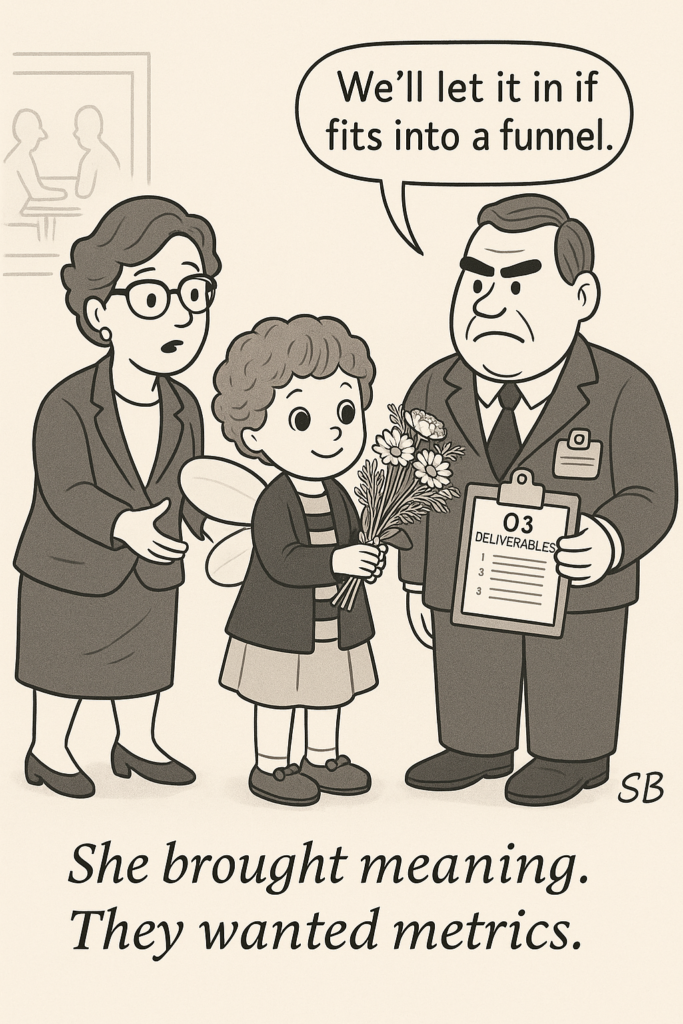A Soulful Meditation on a Discipline Misunderstood

Has Business Ever Really Understood Marketing?
Design has long been welcomed into the boardroom — trimmed, tailored, and assimilated into the clean lines of advertising. But marketing? That’s a trickier guest. Business has often shaken hands with it, nodded in polite acknowledgment, maybe even complimented its sparkle in a deck — but rarely, if ever, understood its soul.
Marketing isn’t just a vehicle for sales. It’s the architecture of meaning.
I’ve been in rooms where marketing was treated like the glitter at the end of a pitch — shiny but disposable. I’ve seen strategy reduced to task lists, creativity mistaken for fluff, and storytelling flattened into timelines and templates. Not because anyone meant harm — but because the system we work in equates clarity with value, and nuance with inefficiency.
And so, here we are. In an era where “design thinking” was briefly the star of the show before being quietly ushered out during a round of cost cuts. Where marketers, once the voice and soul of a brand, are now metrics managers, conversion chasers, and dashboard keepers.
Not because we lost our way — but because we were told this was the way in.
We Became Fluent in Their Language
For two decades, marketers and designers did the hard work of translation. We learned the vocabulary of business. We swapped “feels right” for “strategically aligned.” We turned instincts into KPIs, storytelling into funnels, and brand into bottom lines.
And for a while, it worked.
“Design thinking.”
“Brand purpose.”
“Customer-centricity.”
These weren’t just buzzwords — they were our bridge. We believed that if we could just sit at the grown-up table and speak the right dialect, we’d get to help decide the menu.
But while we became fluent in business, business never learned to speak us.
Performance Without Resonance
The assimilation was one-sided.
In the name of alignment, we diluted the messy magic that gave marketing its power. We let emotion be labeled indulgent. We watched ambiguity get axed for being inefficient. And we let nuance — the very thing that makes humans connect — be trimmed to fit neat performance boxes.
We now have brands that perform but don’t resonate. Campaigns that convert but don’t connect. Stories so optimized, they forgot how to make people feel.
It’s not a crisis of creativity. It’s a crisis of culture.
Business loves clarity. But it forgets that clarity is not the same as depth.
Marketing Is Not a Plug-and-Play Utility

She brought beauty, culture, and connection. He brought the checklist.
Here’s the thing: Marketing isn’t a support function. It’s not the paint on the walls or the playlist in the waiting room. It’s the architecture of meaning. It’s how a company is felt, remembered, and loved.
To reduce it to a series of tactics — a last-mile channel for product — is to fundamentally misunderstand what it does.
Design isn’t just decoration. Marketing isn’t just delivery. They are cultural forces. Lenses. Languages. And they don’t work when stripped of their voice.
Yet, in trying so hard to be measurable, we became palatable. In trying so hard to be understood, we allowed ourselves to be misread.
Maybe It’s Time to Reclaim the Mess
And still — marketers keep asking the same questions:
How do we become more strategic?
More data-driven?
More “like them”?
Maybe it’s time we stop.
Maybe the better question is: What happens when marketing leads — not follows?
What if the very things business was taught to fear — contradiction, tension, emotion — are the things it now needs most?
Because marketing done well doesn’t just drive growth. It shapes belief. It nudges culture. It builds brands that live beyond quarterly reviews.
We don’t need to be more like them. We need to remind them what they forgot.
Marketing has always done the heavy lifting. It has been the voice, the story, the pulse. But somewhere along the way, it got boxed in — turned into a cost center, a service function, a department that “makes things pretty.”
But it was never just that.
Marketing, at its best, doesn’t just follow the business. It defines it.
It dares. It disagrees. It digs into tension and surfaces truth. It doesn’t settle for performance alone — it demands resonance.
And maybe, just maybe, it’s time we stopped proving our worth in their terms — and started writing our own.
Because nodding isn’t listening.
And fitting in was never the goal.
